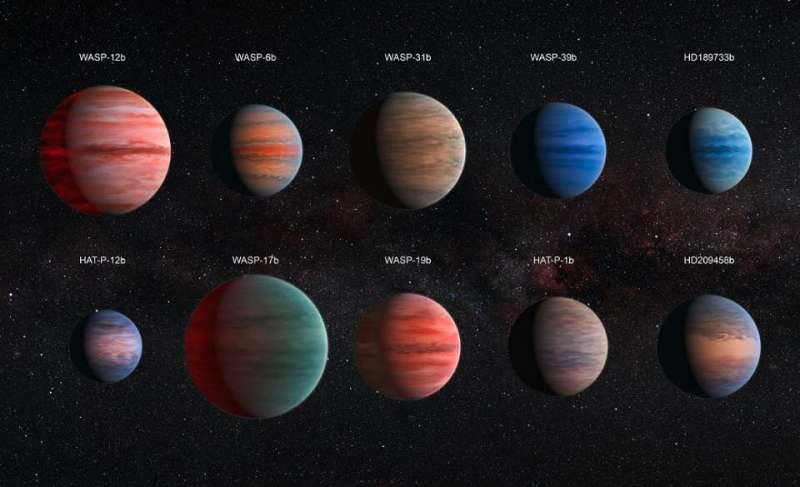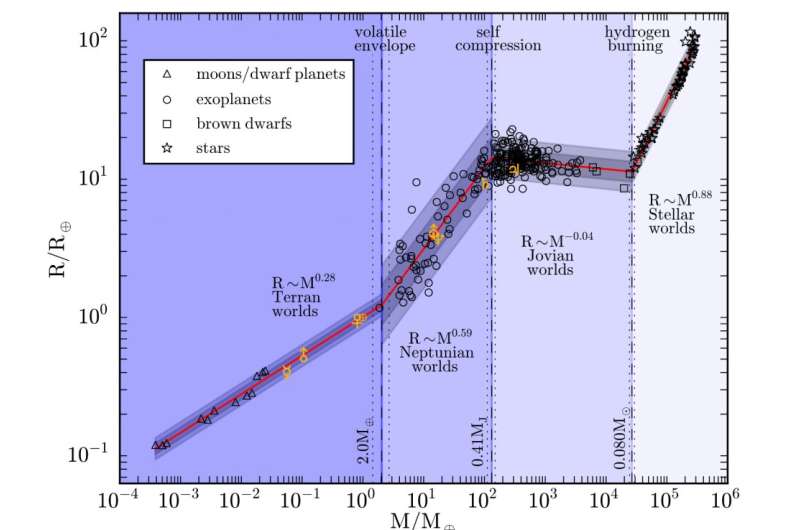How large can a planet be?

Jupiter is the largest planet in the solar system. In terms of mass, Jupiter dwarfs the other planets. If you were to gather all the other planets together into a single mass, Jupiter would still be 2.5 times more massive. It is hard to understate just how huge Jupiter is. But as we've discovered thousands of exoplanets in recent decades, it raises an interesting question about how Jupiter compares. Put another way, just how large can a planet be? The answer is more subtle than you might think.
The simple answer is that a large planet is anything too small to be a star. The usual definition for a star is that it must be large enough to fuse hydrogen into helium in its core. A main-sequence star is one in which the heat and pressure generated by fusion are balanced by the gravitational weight of the star.
Stars are mostly made of hydrogen and helium, and it's safe to assume that the largest planets would have a similar composition. The sun is made of about 75 percent hydrogen and 24 percent helium, the other 1 percent being heavier elements. Jupiter is roughly 71 percent hydrogen, 24 percent helium, and 5 percent other. So let's figure any large planet is three parts hydrogen to one part helium.
As long as there's no fusion going on, a large planet will be in a state of hydrostatic equilibrium. That means the weight of all that gas trying to collapse on itself is balanced by the pressure of the gas not wanting to be squeezed. The more mass you have, the more the interior is squeezed, and the hotter it gets. With enough mass, the interior gets hot enough for hydrogen to start fusing into helium. That critical mass is about 80 Jupiters. Anything with more mass than that must be a star.

But that's not the best upper limit, because there are objects in the universe known as brown dwarfs. These objects are star-like because they aren't in hydrostatic equilibrium. Their interiors generate heat like a star, and they can even fuse hydrogen into deuterium, just not helium. On the other hand, the smallest brown dwarfs have cool, cloudy surfaces, and would look like a planet. The lower limit of mass for a brown dwarf is about 13 Jupiter masses.
In terms of mass, 13 Jupiter masses is a good upper limit. But when it comes to large planets, the most massive ones aren't actually the largest in size.
Unlike solids, which don't compress much under pressure, gases can compress significantly. So as you add mass to a gas planet, its volume doesn't increase by the same amount. For example, Jupiter is three times the mass of Saturn but is less than 20 percent larger by volume. Going back to our model of hydrostatic equilibrium, the most massive planets are actually smaller than Jupiter in size.
A few years ago Jingjing Chen and David Kipping looked at how the size of planets can vary depending on their mass. They found that there is a transition point between Neptune-type worlds where more mass tends to increase their size and Jupiter-type worlds where more mass tends to simply compress the gas more. That critical point is about half the mass of Jupiter, so the largest planets should have around that mass. This agrees with observation. The largest confirmed exoplanet is WASP-17b. It is roughly twice the size of Jupiter but has only 49 percent of Jupiter's mass.
Of course, there are other factors that come into play, such as composition and temperature. The largest known exoplanets tend to be hot Jupiters orbiting close to their star. This means they are much warmer and less dense than a cold jovian planet like Jupiter. Jupiter also has a dense rocky core, which means it is smaller than it would be if it were made only of hydrogen and helium.
But even taking these factors into account, jovian planets are clearly both the largest and most massive planets that can exist. Jupiter isn't the largest planet in the universe, but it is one of the giants.
More information: Jingjing Chen et al. Probabilistic Forecasting Of The Masses And Radii Of Other Worlds, The Astrophysical Journal (2016). DOI: 10.3847/1538-4357/834/1/17
Journal information: Astrophysical Journal
Source Universe Today



















